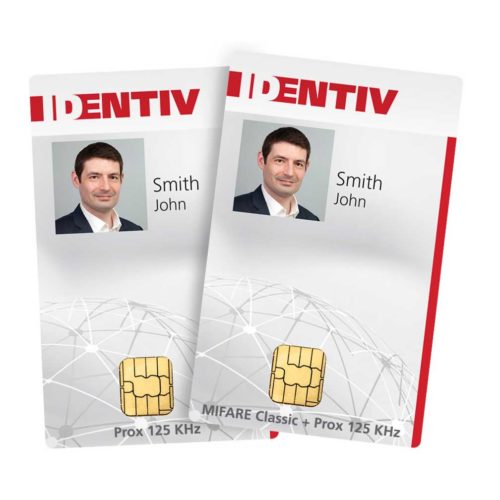The Wiegand interface is a de facto wiring standard which arose from the popularity of Wiegand effect card readers in the 1980s. Wiegand is a technology invented in the 1970s by John Wiegand and is commonly used to connect a swipe mechanism to the rest of an physical access control system (PACS). While the term “Wiegand” actually refers to a variety of things (the Wiegand effect, the Wiegand wiring standard, and Wiegand protocol).
A Wiegand reader, or sensor, is used to pick up the information on a Wiegand device. Some of the information held on these devices include:
- Credit card numbers
- Bank account numbers
- Employee identification information
- Criminal records
- Medical histories
The set of wires that contains this information is incredibly difficult to counterfeit or duplicate. In order for these systems to be utilized, a Wiegand reader will pick up the information found on the device. This is what we call the Wiegand effect.
Typically, Wiegand technology is found in cards, fingerprint readers, or any other data-capturing devices. When an access card such as a contactless Prox or MIFARE card with a Wiegand format (i.e. 26-bit, 37-bit, etc) is held near a compatible card reader, the reader receives the information encoded on the card’s tiny integrated circuit. This is typically a facility code and a card serial number. This data on the card (a series of 1s and 0s) is permanently written onto the card and cannot be changed.
The reader then converts that series of 1s and 0s into electrical pulses per the Wiegand interface standard which is made up of 3 wires: a common ground, DATA0 (aka Data Low) and DATA1 (aka Data High). In order to send the 1s and 0s to the controller, the reader will drop the voltage on the respective DATA wire in rapid succession; 1s over DATA1 and 0s over DATA0. The controller detects these changes in voltage and reinterprets them as 1s and 0s in the firmware.
Wiegand systems are slowly being replaced by newer protocols such as OSDP (Open Supervised Device Protocol).
OSDP is a protocol that links control devices together and guarantees maximum security. Through AES-128 encryption and constant monitoring, OSDP features advanced features to protect your system from all threats.
OSDP features include:
- Functionality across a wide range of security solutions and devices, regardless of the equipment manufacturer.
- This includes secured access doors and gates, control panels (CPs), and peripheral devices (PDs) like card readers
- OSDP can also be used in Internet Protocol (IP) environments. We recommend using OSDP when other protocols like Transmission Control Protocol/Internet Protocol TCP/IP and USB aren’t available.
- OSDP’s interoperability will extend even further when OSDP over IP is released.
- Advanced user interfaces, including text, prompts, and welcome messages.
- Uses two wires instead of the 12 or more found in other legacy systems.
- Using two wires allows supervised connections, scalability, and multi-drop installation.
- Uses an audio-visual system, which is equipped with a user feedback mechanism that creates a user-friendly access control environment.
- The user won’t have to do any guesswork, since authentication processes and encryption have been predefined.
- Costs less to implement on devices that are already embedded into the system, which makes OSDP an easy-to-install choice for many.
- Has tamper messages, which means you will automatically get alerts if there is tampering.
Related Products
Related Articles
Identiv and Zwipe Partner to Provide Biometric Access Control Card Services
FREMONT, Calif., September 14, 2017 — Identiv, Inc. (NASDAQ: INVE) today announced that the company has partnered with biometric technology company Zwipe for access control card formatting services. Identiv’s U.S.-based card service bureau is programming the radio frequency identification (RFID) chips in
Identiv Expands Partnership with PSA Security Network to Include Complete Portfolio of Hirsch PACS Solution
FREMONT, Calif., August 25, 2017 — Identiv, Inc. (NASDAQ: INVE) today announced that the company has expanded its partnership with PSA Security Network to distribute the complete line of Hirsch by Identiv physical access control system (PACS) and security management
Hirsch by Identiv’s U.S. Government FICAM Solution Selected as Winner in 2016 Government Security News Homeland Security Awards
FREMONT, Calif., Jan. 04, 2017 -- Identiv, Inc. (NASDAQ:INVE) today announced that its award-winning Hirsch government Federal Identity, Credential, and Access Management (FICAM) solution, developed to implement a simple, affordable FICAM-compliant solution simply with optimal performance, has been selected by Government Security
Innovative Access Control Technology From Identive Revolutionizes Integrated Identity Management
SANTA ANA, Calif. and ISMANING, Germany, March 13, 2012 -- Identive Group, Inc. (Nasdaq:INVE) (Frankfurt:INV), today introduced TouchSecure OpenAccess™, a family of revolutionary access readers that enable a broad range of organizations to upgrade and integrate their physical and logical
Security Industry Experts From Identive Group Provide Leadership to Government at NIST FIPS 201-2 Workshop
SANTA ANA, Calif. and ISMANING, Germany, April 18, 2011 -- Identive Group, Inc. (Nasdaq:INVE) (Frankfurt:INV), a provider of products, services and solutions for the security, identification and RFID industries, today announced that two of its security industry experts will speak
SCM Microsystems Stockholders Approve Proposed Merger With Hirsch Electronics Corporation
04/17/2009 FREMONT, Calif. and ISMANING, Germany -- SCM Microsystems, Inc., a leading provider of solutions that open the Digital World, today announced that its stockholders have approved the issuance of shares of SCM common stock and warrants to purchase


